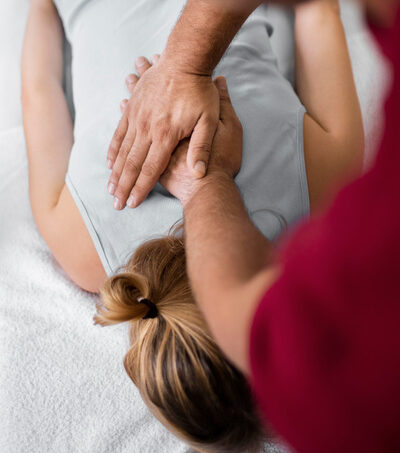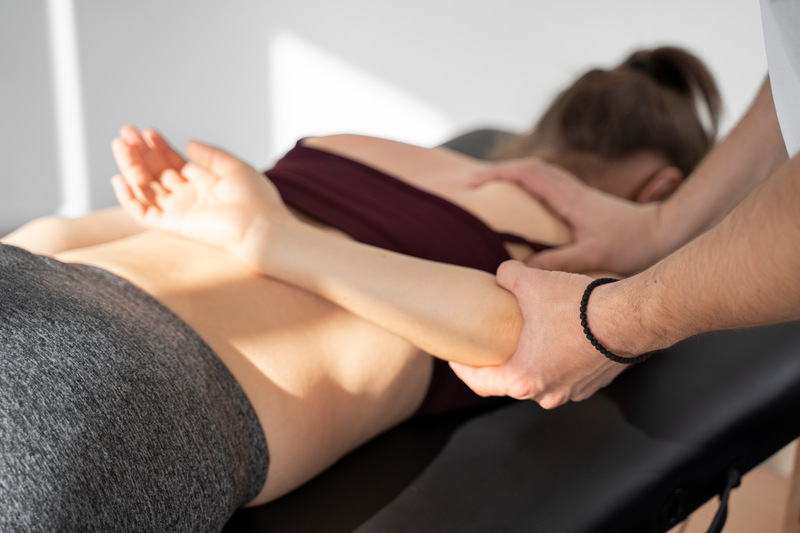In the world of fitness and athletic performance, the significance of post-training recovery cannot be overstated. One valuable tool gaining prominence in this context is sports massage. In this article, we’ll delve into the physiological processes during training, the importance of effective recovery, and the role of sports massage in accelerating the post-training recovery phase.
Physiological processes during training

Cardiovascular system
- Increased heart rate: Exercise prompts the heart to pump blood at an accelerated rate to deliver oxygen and nutrients to working muscles.
- Dilation of blood vessels: Blood vessels widen to enhance blood flow, optimizing oxygen delivery and waste removal.
Respiratory system
- Elevated breathing rate: The respiratory system adapts by increasing the rate and depth of breaths, facilitating the exchange of oxygen and carbon dioxide in the lungs.
- Oxygen uptake: Oxygen is transported from the lungs to the bloodstream, where it binds to hemoglobin for distribution to muscle tissues.
Muscular system
- Muscle contraction: Exercise triggers muscular contractions, requiring the breakdown of adenosine triphosphate (ATP) for energy.
- Lactic acid production: Intense exercise may lead to the accumulation of lactic acid as a byproduct, contributing to muscle fatigue.
Thermoregulation
- Heat production: Muscular activity generates heat, necessitating thermoregulatory mechanisms such as sweating to dissipate excess heat.
- Maintaining core temperature: The body strives to maintain a stable core temperature to optimize enzyme function and prevent overheating.
Endocrine system
- Release of hormones: The endocrine system responds by releasing hormones such as adrenaline and cortisol, mobilizing energy stores and enhancing alertness.
- Regulation of metabolism: Hormones play a crucial role in regulating metabolism, influencing how the body utilizes nutrients during exercise.

The importance of post-exercise recovery
Tissue repair and adaptation
Restoration of energy reserves
Reduction of muscle soreness
Hormonal balance and mental well-being
Prevention of overtraining and injury
Immune system support
Intense exercise temporarily suppresses the immune system. The post-exercise recovery phase is crucial for immune system restoration, reducing the risk of illness and ensuring the body’s overall resilience.
In essence, post-exercise recovery is not merely a passive period but a proactive investment in long-term health and fitness. Recognizing its importance and incorporating effective recovery strategies, such as adequate rest, hydration, and nutrition, ensures that each workout contributes positively to overall well-being and performance.
The role of sports massage in accelerating recovery
Sports massage plays a pivotal role in optimizing the post-training recovery process, offering a multifaceted approach to enhance both physiological and psychological aspects of recuperation.
One of its primary contributions lies in the alleviation of muscle tension. Intense physical activity can lead to the accumulation of tension within muscle fibers, hindering flexibility and impeding the natural recovery process. Sports massage employs a variety of techniques, such as effleurage and kneading, to release this tension and restore muscle elasticity.
Beyond tension release, sports massage facilitates improved blood circulation. Enhanced circulation promotes the efficient delivery of oxygen and nutrients to fatigued muscles while aiding in the removal of metabolic byproducts. This heightened circulatory response contributes significantly to the overall reduction of recovery time.
In addition to its physiological benefits, sports massage addresses the psychological aspects of recovery. The calming and relaxing nature of the massage can positively impact the nervous system, reducing stress hormones and promoting a sense of well-being. This psychological relief is instrumental in preventing burnout and supporting a positive mindset towards ongoing training.
Furthermore, sports massage has been associated with the reduction of delayed onset muscle soreness (DOMS). By minimizing inflammation and promoting the repair of microtears in muscle tissues, sports massage contributes to a more comfortable post-exercise experience, encouraging consistent engagement in physical activity.
Overall, the role of sports massage in accelerating recovery extends beyond the physical realm. It intertwines the physiological and psychological components of recuperation, creating a holistic approach that complements and enhances the benefits of post-training recovery. Its application stands as a valuable strategy in promoting sustained athletic performance and overall well-being.

Recovery-focused massage techniques
Effleurage
Kneading
Compression Techniques
Stretching Movements
Trigger Point Therapy

Contraindications and safety in sports massage
Sports massage, while generally safe and beneficial, necessitates careful consideration of certain contraindications and safety measures to ensure a positive and risk-free experience.

